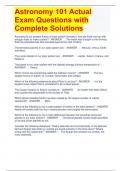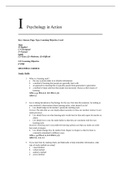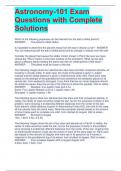Astronomy 101 exam 1 - Study guides, Class notes & Summaries
Looking for the best study guides, study notes and summaries about Astronomy 101 exam 1? On this page you'll find 16 study documents about Astronomy 101 exam 1.
Page 2 out of 16 results
Sort by

-
Introduction To Astronomy 101 Final Exam Questions With Correct Answers For Perfect Revisions.
- Exam (elaborations) • 1 pages • 2023
-
- $5.29
- + learn more
Introduction To Astronomy 101 Final Exam Questions With Correct Answers For Perfect Revisions. If the radius of an object's orbit is halved, and angular momentum is conserved, what must happen to the object's speed? - correct answers.It must be doubled. Unlike the giant planets, the terrestrial planets formed when - correct inner Solar System was hotter than the outer Solar System The terrestrial planets and the giant planets have different compositions because - correct ...

-
ASTRONOMY EXAM 1 STUDY GUIDE: AST 101 Exam 1 Questions and Answers
- Exam (elaborations) • 17 pages • 2022
-
- $11.50
- + learn more
• Question 1 2 out of 2 points In order to protect all parties and minimize misunderstandings among partners, all terms of the partnership should be spelled out in writing. Selected Answer: True Answers: True False • Question 2 2 out of 2 points Inflation refers to a general rise in the prices of goods and services over time. Selected Answer: True Answers: True False • Question 3 2 out of 2 points When a group of investors take a firm p...

-
Astronomy 101 Actual Exam Questions with Complete Solutions
- Exam (elaborations) • 28 pages • 2023
-
Available in package deal
-
- $11.89
- + learn more
Astronomy 101 Actual Exam Questions with Complete Solutions According to our present theory of solar system formation, how did Earth end up with enough water to make oceans? - ANSWER The water was brought to the forming Earth by planetesimals that accreted beyond the orbit of Mars. The terrestrial planets in our solar system are: - ANSWER Mercury, Venus, Earth, and Mars. The jovian planets in our solar system are: - ANSWER Jupiter, Saturn, Uranus, and Neptune. The pl...

-
PSY 101/Psychology 101 Test Bank
- Exam (elaborations) • 1116 pages • 2021
-
Available in package deal
-
- $20.49
- + learn more
PSY 101/Psychology 101 Test Bank Psychology in Action The Science of Psychology Psychology in Action Key: Answer, Page, Type, Learning Objective, Level Type A=Applied C=Conceptual F=Factual Level (1)=Easy; (2)=Moderate; (3)=Difficult LO=Learning Objective p=page MULTIPLE CHOICE Study Skills 1 What is a learning style? a the way a person takes in or absorbs information b a method of learning that people are generally born with c an approach to learning that is typically passed f...

-
Astronomy-101 Exam Questions with Complete Solutions
- Exam (elaborations) • 4 pages • 2023
-
Available in package deal
-
- $11.89
- + learn more
Astronomy-101 Exam Questions with Complete Solutions Which of the following properties can be inferred from the star's orbital period? - ANSWER The planet's orbital radius Is it possible to determine the planet's mass from the star's velocity curve? - ANSWER Yes, by measuring both the star's orbital period and its change in velocity over the orbit Consider the planet that causes the stellar motion shown in Plot 2 (be sure you have clicked the "Plot 2" button in the l...

-
Bundle For Astronomy 101 2023 Exam Questions with Complete Solutions
- Package deal • 9 items • 2023
-
- $55.39
- + learn more
Astronomy 101 Actual Exam Questions with Complete Solutions 2 Exam (elaborations) Astronomy 101 End of Sections Test Questions with Complete Solutions 3 Exam (elaborations) Astronomy 101 Final Exam Questions with Complete Solutions 4 Exam (elaborations) Astronomy 101 Exam 1 Questions with All Correct Answers 5 Exam (elaborations) Astronomy 101

That summary you just bought made someone very happy. Also get paid weekly? Sell your study resources on Stuvia! Discover all about earning on Stuvia


